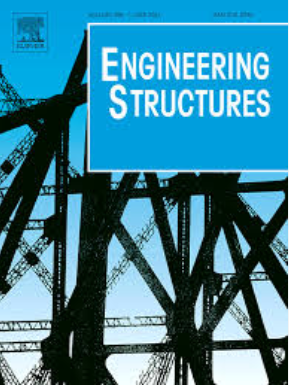基于粒子群算法的时域稀疏贝叶斯学习平板轨道系统CA砂浆空洞检测
IF 5.6
1区 工程技术
Q1 ENGINEERING, CIVIL
引用次数: 0
摘要
首次提出了一种基于粒子群优化(PSO)算法的时域稀疏贝叶斯学习方法,用于平板轨道系统水泥乳化沥青砂浆的空隙识别。CA砂浆的空洞识别过程涉及稀疏贝叶斯学习框架中的迭代期望最大化技术,利用测量的时域振动数据计算CA砂浆刚度分布的损伤参数和超参数。采用粒子群算法对目标函数进行最小化,得到损伤参数的最可能值。首先进行了全面的数值算例研究,验证了所提出方法的可行性,然后研究了加速度计放置对CA空洞检测结果的影响。为了进一步验证所提方法的适用性,对按比例调整的平板轨道模型进行了冲击锤试验。结果表明,利用该方法可以很好地识别CA砂浆的空洞位置和严重程度,并利用损伤参数的后验协方差矩阵计算相关的后验不确定性,使其保持在可接受的水平。本文章由计算机程序翻译,如有差异,请以英文原文为准。
Time-domain sparse Bayesian learning with PSO algorithm for CA mortar void detection of slab track system
A newly developed time-domain sparse Bayesian learning methodology with the particle swarm optimization (PSO) algorithm was proposed for the void identification in the cement-emulsified asphalt (CA) mortar of the slab track system for the first time. The CA mortar void identification process involves an iterative expectation maximization technique in the sparse Bayesian learning framework to calculate the damage parameters and hyperparameters for the CA mortar stiffness distributions utilizing measured time-domain vibration data. The PSO algorithm was incorporated to minimize the objective function for obtaining the most probable values of damage parameters. Comprehensive numerical case studies were firstly carried out to validate the feasibility of the proposed methodology, and then the effects of accelerometer placement on the CA void detection results were investigated. In order to further experimentally demonstrate the applicability of the proposed methodology, impact hammer tests were conducted on the scaled slab track models. Encouraging void identification results indicate that the CA mortar void location and severity can be successfully identified with very high accuracy by utilizing the presented methodology, and the associated posterior uncertainties were calculated by utilizing the posterior covariance matrix of the damage parameters, which were kept at an acceptable level.
求助全文
通过发布文献求助,成功后即可免费获取论文全文。
去求助
来源期刊

Engineering Structures
工程技术-工程:土木
CiteScore
10.20
自引率
14.50%
发文量
1385
审稿时长
67 days
期刊介绍:
Engineering Structures provides a forum for a broad blend of scientific and technical papers to reflect the evolving needs of the structural engineering and structural mechanics communities. Particularly welcome are contributions dealing with applications of structural engineering and mechanics principles in all areas of technology. The journal aspires to a broad and integrated coverage of the effects of dynamic loadings and of the modelling techniques whereby the structural response to these loadings may be computed.
The scope of Engineering Structures encompasses, but is not restricted to, the following areas: infrastructure engineering; earthquake engineering; structure-fluid-soil interaction; wind engineering; fire engineering; blast engineering; structural reliability/stability; life assessment/integrity; structural health monitoring; multi-hazard engineering; structural dynamics; optimization; expert systems; experimental modelling; performance-based design; multiscale analysis; value engineering.
Topics of interest include: tall buildings; innovative structures; environmentally responsive structures; bridges; stadiums; commercial and public buildings; transmission towers; television and telecommunication masts; foldable structures; cooling towers; plates and shells; suspension structures; protective structures; smart structures; nuclear reactors; dams; pressure vessels; pipelines; tunnels.
Engineering Structures also publishes review articles, short communications and discussions, book reviews, and a diary on international events related to any aspect of structural engineering.
 求助内容:
求助内容: 应助结果提醒方式:
应助结果提醒方式:


